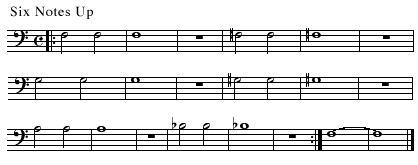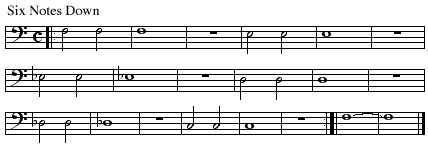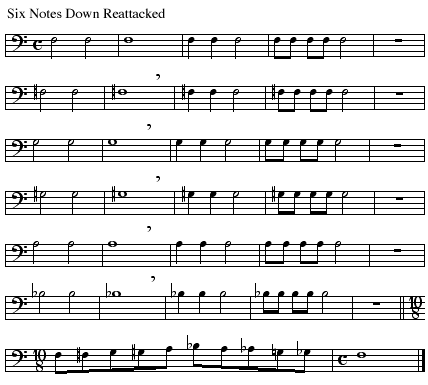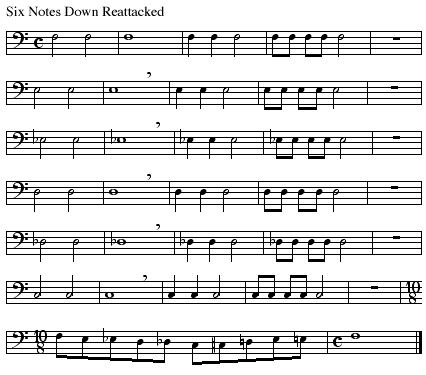Letters from New York: Carmine Caruso and the Six Notes
The Six Notes
Carmine Caruso was a great teacher of brass instruments in New York City from the late 1930s through the 1980s. He was someone with whom I studied for over 20 years, and someone to whom I owe a great deal of my success as far as physically playing the instrument.
Carmine called his first and most basic exercise the "Six Notes." It is almost infinitely variable, but I will first present it to you (as closely as I can) exactly as he first gave it to me.
As with all of Carmine's exercises, the first thing he asked a student to do was to start tapping their foot. (For this particular exercise, at about 80 beats per minute.) While doing this, the student was to mentally subdivide this beat into sixteenth-notes. This is an important part of almost all of Carmine Caruso's exercises, and bears further explication.
Any physical act is performed by hundreds of muscles, directed by thousands and millions of nerves and synapses. The most common way that physical activities are taught is through repetition, rote learning, and imitation. A martial arts teacher or baseball batting coach might use phrases like "stand this way," "take this stride," "make this motion with the arms just so." "Good, you've got it...now repeat it a thousand times." At the end of that thousand repetitions, if the stride and arm position fits the physical system of the one being taught, that particular motion will be fairly well locked in. The coach might criticize and fine tune, saying "No, hold that left elbow a little higher, now arch your back and pivot on the right front side of your right foot," isolating very specific physical actions and positions and correcting them until the "proper" form has been reached. That's the way most sports and most instrumental technique has historically been taught.
There are literally hundreds of muscles and thousands of neurons involved in the simplest physical action, and it is impossible to be aware of all of them. However, by applying physical time to the coordination of these various physical parts they can be synchronized and balanced out in such a way as to provide the most efficient possible set of actions that each individual can use in the performance of any given task.
Carmine expanded upon this idea all his life and came to the conclusion that, rather than thinking about each individual muscle one might use or position one might have to take to perform a certain act, by applying a very finely perceived sense of time to an action the muscles and nerves would of their own accord find the best manner of gathering themselves and executing the desired action at the precisely desired time. In other words, by applying time to any physical action, one could "time in" that action and make it as efficient and effective as possible, without the interference of the mind. Thus, the tapping foot and mental subdivision.
Once you are tapping and subdividing, play example one. I call this version the "Six Notes Up."

Do so without removing the mouthpiece from your lips. Carmine taught us to breathe through the nose for these exercises, but personally I have found that this way of taking in air sometimes tends to constrict my throat somewhat, and at those times I choose to breathe through the corners of my mouth. However you choose to breathe, do not dislodge or alter the placement of your mouthpiece on your embouchure any more than is absolutely necessary.
For now, play the exercise at a good healthy mezzo-forte, and don't stop no matter how it sounds. If it sounds "bad," that's fine. It means you need work on the parameters of playing that this exercise addresses. If it sounds "good," that's also fine. It means you are reinforcing some good habits.
Tongue the notes as follows: "Tah-Dah-Hah." That is, a "T" attack on the first half note of two bars, a "D" attack on the second (the airstream very briefly interrupted by the tongue), and a breath attack (no tongue at all, the airstream briefly and gently stopped and then started again) on the final whole note. Breathe during the silent bars.
A note on the "Hah" attack: Carmine used the metaphor of the swinging doors in a western cafe to illustrate the proper balance of the lips for a brass player. If those doors were to be adjusted improperly, they would either be too close and clack together, sticking when they should be swinging and stubbornly refusing to move properly and easily, or they would be too far apart and swing wildly back and forth without ever touching at all, never establishing any relationship whatsoever to one another. If, however, those doors were to be perfectly balanced, the slightest breeze would cause them to swing gracefully back and forth, and their swinging would be adjusted and timed in by their just meeting in the middle of every cycle.
The "Hah" attack is the key to this whole exercise, in my opinion. There are many possible ways to stop a note: slamming the tongue up on the roof of the mouth; cutting off the breath somewhere in the throat; pressing the lips together so they will no longer vibrate; but the simplest and best is to just stop blowing. When you do so, the lips (if they are in good balance) will simply stop vibrating and come to rest in the perfect position to begin the next note.
Therefore, just stop blowing at the end of the second half note. If you do so, and if you have achieved a proper balance between your lips, you will feel a very subtle closing. It will not feel exactly like the sound of the letter "P" at the end of a word, but more like the beginning of that sound. Whisper the word "pop" as quietly as you can. Now do it again, and this time make sure you don't open your lips and let air escape after you sound the second "p." That's an approximation of the feeling you should be looking for when you end the second half note of this exercise and prepare to execute the "Hah" attack. When the lips are perfectly balanced, the slightest hint of air will set them in motion. That same non-percussive "p" feeling should occur when you end the last whole note of each pitch.
I use this exercise as the basis for almost everything I do on all the horns I play, and I would recommend doing it at the start of any playing or practice session. It is an ideal beginning to a thorough warm up and can be endlessly varied. However, just as it is presented here it is a wonderful exercise for giving yourself an anchor, a balanced base from which to proceed in any direction on the horn.
More on Foot Tapping: The World's Shortest Lesson Part I
I would like to digress for a moment here and say a little more about the application of time to problems one might have with playing. After I had been studying with Carmine Caruso for a number of years, I gradually stopped taking regular lessons with him, preferring to only go in for a lesson when something was bothering me on the horn.
During this period of time, I was hired to do a short run revival of the rock musical Jesus Christ Superstar in a fairly small Broadway theater, and it turned out to be a very badly produced show; short of money, short of room, short of everything. To top it off, they hired a couple of reed players who just couldn't play. A Gato Barbieri style tenor player was asked to double on oboe even though he barely knew how, for example. To top it off, because of space considerations in the pit, they put the horn section 200 feet away from the rhythm section, in the upper balcony.
The result of all this was that every time we saw the conductor give a downbeat we'd hear the rhythm section about three quarters of a second later. This, plus the pitch problems in the horn section, proved to be very destructive to all the brass players' setups, and after about four days of rehearsal I found that I couldn't count on being able to attack any note, anywhere on the horn. I tried everything I knew while practicing at home, but the problem just kept getting worse. As I was just beginning to get some good recording work in New York at the time, I really didn't want to screw it up by walking into a session and not being able to cleanly attack a middle Bb, so I called Carmine and asked if I could drop over to his studio and take an emergency lesson. He said fine, come on up, and I did.
Carmine ran a very informal studio. He had just two rooms in an old Broadway office building, one for the students to wait in, and the other for the lessons. It was furnished in what looked to be second hand furniture from the 1930s and piles of old magazines, and Carmine usually sat in a battered old armchair in his undershirt, smiling his inimitable smile and looking for all the world like the Buddha reincarnated as an old Italian music teacher. Come to think of it, maybe he was.
After I explained my problem he said that I should sit down and play the "Six Notes" for him. I had been studying with him long enough to know that I should tap my foot for four beats before commencing the exercise, and I started to do so. I got maybe two or three foot taps out and Carmine stopped me.
He gave me an even bigger smile and said "You're not listening to your foot."
I paused for a minute to let that sink in; tapped my foot four times while consciously subdividing and paying attention to what I was doing, and succeeded in attacking a note cleanly for the first time in almost a week.
"OK, that's enough, go home and practice and you'll be fine." was all Carmine had to say, and he was right. The importance of good time cannot be overstated.
As a side note to all of you who may be performing in an area where foot tapping is looked down up (usually situations with characteristically weak time), just be subtle about it. You don't have to bang your shoe on the ground to tap time, just wiggle your toe a little. Sometimes, in some performance situations, you just have to define the time for yourself. Physically.
The Six Notes: Variation Two
The second variation is the "Six Notes Down." This is the "Six Notes" played in the same "Tah-Dah-Hah" manner as the "Six Notes Up," only inverted.

This exercise establishes a balance around fourth-line F just as the previous one does, but that balance tends a little bit towards the lower end of the horn rather than the higher. This is a subtle difference, but eventually it can be quite important.
I have many variations on these two exercises; I want to present one of the two most important ones here, a version I call the "Six Notes Up Reattacked."

Play the first two bars just as you would the basic "Six Notes." Take a quick breath (disturbing your setting as little as possible) then play the next two bars marcato. (In the second two bars, think "Tah Tah Taah, Tah Tah Tah Tah Taah." Not short, not long, just slightly detached.) Pay particular attention to the lips; try to feel them gently meeting after the two quarter notes and the half note in the third bar of every phrase, not meeting after the eighth notes of the fourth bar, and them gently meeting again after the last half note of each phrase. Treat the eighth notes in the 10/8 bar as you do the other eighth notes. This exercise expands upon the effects of the "Six Notes" by somewhat providing a chance to further balance the relationship between the lips after a few attacks. Notice that this exercise and the one that follows are not marked with repeat signs.
Producing good attacks at all volumes and in all ranges is usually one of the most serious problems facing a brass player. The daily use of these "Reattacked" variations on this and other exercises will provide invaluable help in establishing the balances and good habits that will eventually result in consistently good attacks.
The Six Notes: Variation Three
The last variation I will present in this article I call the" Six Notes Down Reattacked." This is the same exercise as the "Six Notes Up Reattacked," only once again inverted.

Now a word about how to use these exercises. Although Carmine Caruso most commonly gave them starting on 3rd partial F, I use them in any and all ranges of the horn. I always play the "Six Notes" from whatever starting note or range I've chosen as my first exercise of the day, and also as the first of any series of exercises whenever I change the starting range in which I'm concentrating. Playing them always helps to establish a certain comfort and balance in the area immediately surrounding those particular pitches.
For example, if I'm fairly well warmed up and wish to concentrate on some high range exercises, I might rest for a few minutes and then play one of the variations on "The Six Notes" from a fairly secure note in a higher register, a note that I can usually attack cleanly and well at a volume of mezzo-piano or mezzo-forte. The same approach would hold true in the lower registers.
It makes no difference if you're playing one of the Rochut Melodious Etudes, practicing the changes to "Donna Lee," doing Remington or Schlossberg exercises, or playing one of the Bach Cello Suites; achieving a good, balanced feeling in your embouchure setting will help you to practice and play them well, and these exercises and concepts of Carmine's plus my variations on them should function to help you find and build that balance.
In the next installment of this series, I will examine some Carmine Caruso's most well known (and most misunderstood) exercises, his interval studies. Until then, enjoy yourself. And as the late, great jazz trombonist J. J. Johnson once said in regard to the idea of "mastering" the trombone, "There will never come a day when you don't have to practice."
